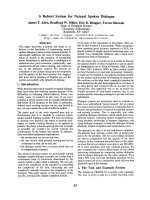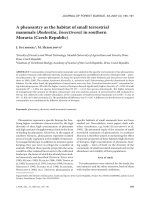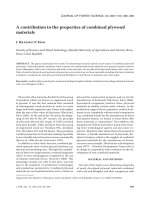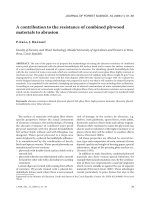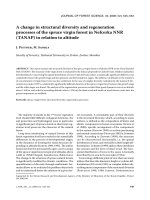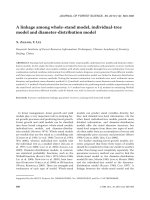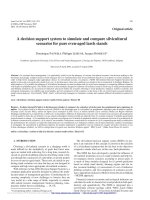Báo cáo lâm nghiệp: "A micropropagation system for Eucalyptus dunnii x Eucalyptus sp" pot
Bạn đang xem bản rút gọn của tài liệu. Xem và tải ngay bản đầy đủ của tài liệu tại đây (287.86 KB, 4 trang )
A
micropropagation
system
for
Eucalyptus
dunnii x
Eucalyptus
sp.
M.
Fantini
Jr.
M.E.
Cortezzi
Graça
2
1
Klabin
do Parana
Agro-Florestal,
Teldmaco
Borda,
PR,
and
2
Centro
Nacional
de
Pesquisa
de
FlorestaslCNPF-EMBRAPA,
PR,
Brazt7
Introduction
A
Eucalyptus
dunnii
hybrid
was
first
no-
ticed
during
seedling
production
in
1984.
This
spontaneous
hybrid
originated
from
a
seed
production
area
of
E.
dunnii
and
its
characteristics,
such
as
leaf
color,
shape,
wax
content
and
stem
color
:.;ere
distinct
from
the
type.
Although
the
hybrid
growth
potential
cannot
yet
be
determined,
early
tree
seiection
revealed
2
important
fea-
tures:
1)
tolerance
to
frost
comparable
to
that
of
the
parental
species,
which
is
a
major
factor
to
consider
in
establishing
Eucalyptus
in
the
southern
region
of
Bra-
zil;
2)
the
hybrid
can
be
easily
propagated
by
stem
cuttings,
as
opposed
to
E.
dunnii.
While
this
method
is
successful,
in
vitro
propagation
would
reduce
propagation
stock
requirements
and
would
also
be
a
rapid
method
for
mass
clonal
propagation.
The
development
of
a
system
to
micro-
propagate
Eucalyptus
dunnii
x
Eucatyp-
tus
sp.
was
the
objective
of
this
study.
Materials
and
Methods
Nodal
segments
of
E.
dunnii
x
Eucalyptus
sp.
were
collected
from
rooted
cuttings
actively
growing
in
an
open
greenhouse.
After
leaf
removal,
segments
were
surface-sterilized
in
1%
NaCIO
plus
2!
drops
of
Tween-20/100
ml
for
15
min
followed
by
3
rinses
in
autoclaved
dis-
tilled
and
deionized
water.
The
basal
medium
for
initiation
consisted
of
Murashige
and
Skoog
(1962)
salts
plus
vitamins
as
described
by
Gamborg
and
W’etter
(1975),
3%
sucrose
with
BAP
(benzylaminopurine)
and
IBA
(indole
butyric
acid)
at
0.1
mg
’
H.
The
pH
of
the
medium
was
adjusted
to
5.7
prior
to
the
addi-
tion
of
6
g’
I-
1
of
Eiacto-agar.
At
the
multiplication
stage,
the
medium
combinations
of
BAP
and
KIN
(kinetin)
(0.1,
0.5
and
1.0
mg!l-!)
and
IBA
(0.01,
0.05
and
0.1
mg!l-!)
were
used.
For
the
shoot
elongation
experiment,
single
shoots
or
clusters
of
shoots
were
placed
on
a
medium
containing
the
treatments
shown
in
Table
I.
Cul-
tures
in
each
treatment
were
incubated
under
16
h/8
h
tight/dark
photoperiod
(around
1200
lux),
at
25°C.
After
60
d
in
culture,
shoot
height
was
recorded.
Fioots
were
initiated
on
Knop
(1985)
or
on
White
(1954)
medium
supplemen-
ted
with
IBA
(0.5,
1.0
and
1.5
mg!l-!)
and
ribo-
flavin
(0
and
5
1!’1-1).
All
experiments
(unless
otherwise
stated)
were
completely
randomized
with
a
variable
number
of
replicates
in
each
stage.
Prior
to
transfer
to
greenhouse
condi-
tions,
the
plantlets
in
the
culture
vessels
were
established
in
50
cm
3
polypropylene
containers
with
a
mixture
of
vermiculite
and
sterile
soil
(1:2.3,
v/v)
under
high
humidity
in
the
green-
house.
After
2
wk
in
this
environment,
the hu-
midity
was
gradually
reduced
to
ambient
condi-
tions.
Results
Optimum
shoot
multiplication
rate
was
obtained
on
the
medium
containing
0.5
mg
’
l-
1
BAP
and
0.05
mg
’
I-
1
IBA
(Table
II).
A
rate
of
8
shoots
per
explant
was
devel-
oped
within
30
d.
When
KIN
was
used,
multiplication
rates
were
lower
than
those
with
BAP.
Nevertheless,
the
same
optimal
levels
as
those
determined
with
BAP
were
found
with
KIN
(6:1 )
(Table 11).
Shoot
elongation
was
influenced
by
the
treatment
(Figs.
1
and
2).
When
only
MS
medium
was
used,
shoot
elongation
did
not
occur
(Fig.
1
The
single
addition
of
AC,
GA
3,
BAP
or
IBA
or
both
at
0.01
mg
’
I-
1
to
the
MS
medium,
increased
shoot
length.
Although
no
significant
difference
was
observed
among
these
treatments,
single
additions
were
not
as
effective
in
promoting
shoot
development
as
they
were
when
combined
(T6).
On
the
other
hand,
increasing
the
BAP
level
(T7)
re-
sulted
in
shoots
shorter
than
those
sub-
jected
to
T6.
Shoots
cultured
in
the
dark
were
more
elongated
than
those
grown
under
16
h
light
photoperiod
(Fig.
1
). In-
oculation
procedures
affected
shoot
grow-
th
only
in
the
treatments
in
which
all
pro-
moters
were
used
(Fig.
2).
Under
those
treatments
(T6
and
T7),
single
shoot
ino-
culation
produced
longer
shoots
compa-
red
to
clusters.
Despite
this
treatment,
shoots
in
cluster
gave
a
higher
yield
of
less
developed
shoots,
but
these
were
still
of
adequate
size
for
rooting.
Rooting
occurred
in
all
treatments
but
it
was
greatest
on
Knop
medium
with
1.0
mg-1-
1
IBA
(Fig.
3).
On
this
medium,
root-
ing
was
82%
compared
to
60%
observed
on
White
medium
at
the
same
IBA
concentration.
Rooting
was
also
stimu-
lated
by
an
IBA
concentration
up
to
1.0
mg!l-1.
As
the
concentration
of
IBA
in-
creased
beyond
1.0
mg
’
I-
1,
root
formation
decreased.
Similarly,
rooting
was
also
reduced
when
riboflavin
(5.0
mg.J-
1)
was
included
in
the
medium.
Survival
of
re-
generated
plantlets
was
90%
after
2
wk
in
the
greenhouse
under
high
humidity.
Discussion
and
Conclusion
Micropropagation
is
a
viable
system
for
mass
propagation
of
E.
dunnii
x
Eucalyp-
tus
sp.
High
shoot
multiplication
rates
were
obtained
with
0.5
mg’I
-1
BAP
or
KIN,
combined
with
0.05
mg!l-!
IBA.
In
this
treatment
combination,
BAP
was
more
effective
in
promoting
shoot
proliferation
than
KIN
was.
At
the
elongation
stage,
the
addition
of
AC,
GA
3,
BAP
(0.05
mg
’
I-
1)
and
IBA
(0.05
mg
’
I-1)
in
the
MS
medium
produced
the
best
shoot
growth.
Although
incubation
in
the
dark
increased
shoot
length,
light
incubated
shoots
grew
more
readily
than
dark
incubated
ones.
Similar-
ly,
elongation
was
better
when
shoots
were
inoculated
on
medium
individually
as
opposed
to
clusters.
Inoculation
of
clus-
ters,
however,
yielded
many
elongated
shoots
with
an
adequate
root
system.
The
best
percentage
of
rooting
was
obtained
on
Knop
medium
with
IBA
at
1.0
m’
H.
Shoots
rooted
better
on
Knop
than
White
medium,
regardless
of
the
IBA
level.
Addi-
tion of
riboflavin
to
the
rooting
medium
has
been
reported
to
improve
root
formation
through
the
modification
of
root
morpholo-
gy.
Fewer
and
longer
roots
were
produced
in
the
presence
of
riboflavin
and
these
roots
developed
towards
the
medium,
whereas
those
initiated
in
the
absence
of
riboflavin
grew
on
the
surface
of
the
medium
(De
Fossard,
1981
). In
the
pres-
ent
study,
the
addition
of
riboflavin
re-
duced
the
rooting
capacity
of
the
explants
and
promoted
the
development
of
an
undesireable
root
system
with
fewer
roots,
which
were
more
brittle
than
those
without
riboflavin
in
all
treatment
combinations.
The
success
of
the
establishment
of
the
regenerated
plantlets
(90%
survival)
under
greenhouse
conditions
indicates,
once
more,
the
potential
of
this
method
to
pro-
pagate
E
dunnii
x Eucalyptus sp.
hybrids.
References
De
Fossard
R.A.
(1981)
In:
Tissue
Culture
Pro-
pagation.
Harold
L.
Lyon
Arboretum
Lecture -
University
of
Hawaii -
Lecture
no.
10,
pp.
39
Gamborg
O.L.
&
Wetter
L.R.
(1975)
In:
Plant
Tissue
Culture
Methods.
National
Research
Council
of
Canada,
Saskatoon,
p.
91
Knop
W.
(1965)
Quantitative
untersuchungen
Ober
den
ernahrugsprozess
der
pflanzen.
Landwirtsch
Vers St.
7,
93-107
Murashige
T.
&
Skoog
F.
(1962)
A
revised
medium
for
rapid
growth
and
bioassays
with
tobacco
tissue
culture.
Physiol.
Plant.
15,
473-
497
White
P.R.
(1943)
In:
A
Handbook
of
Plant
Tis-
sue
Culture.
The
Jaques
Cattel
Press,
Tempe,
AR
